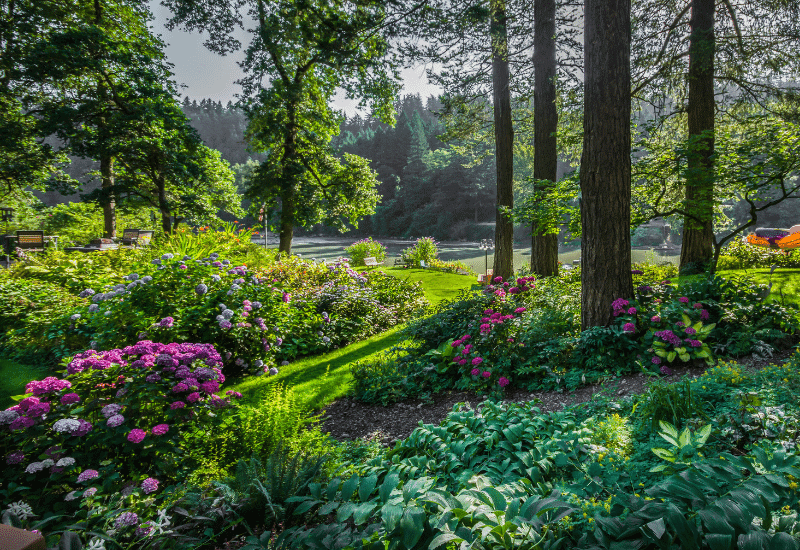
“Nothing grows under pine trees!” You must have heard it many times, but it’s a myth, and I am going to prove it to you.
True, many plants will become sick and even die, or they won’t sprout at all under conifers, and it’s a matte of habitat. In fact, fallen pine needles lower the soil pH to about 5.5; next, they have a very dense canopy all year round, which blocks the light.
But you shouldn’t give up and turn to stones, features or pots for landscaping your woodland area…
To succeed with landscaping underneath of a pine tree, you must choose acid-loving plants that can withstand shade and drought.
This will greatly influence your choice, but there are still many plants, including ferns, mosses and many different types of grass, for example, have no problem with such locations.
There are also a number of flowering plants, small shrubs and ground cover plants that are suitable for planting under under pine trees, firs, cedars and other conifers.
Discover our selection of plants that grow under trees. Along with advice on gardening beneath pine trees so that the bare feet of your pine trees are finally adorned with beautiful flowers and foliage.
The Problem: Why Few Plants Grow Under Pine Trees
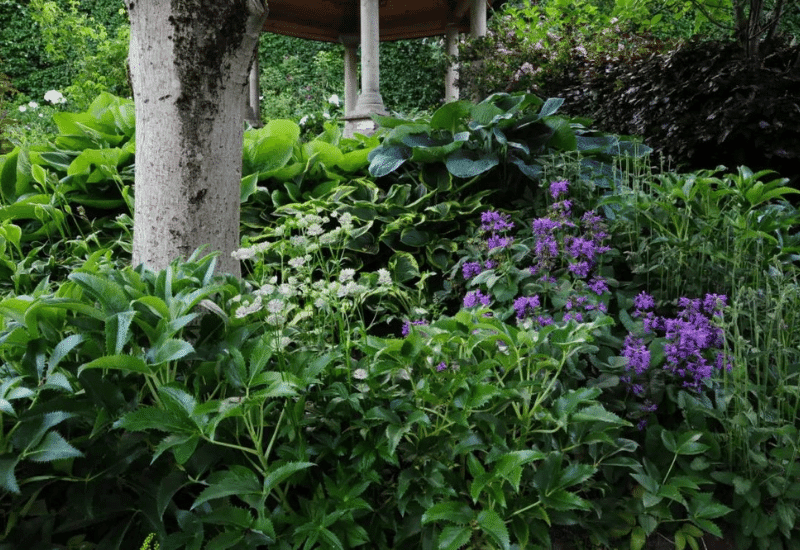
Let’s first look at what happens under pine trees exactly first, to understand why these plants will thrive there.
All trees have an important role in the ecosystem and in the creation of different habitats, and pine trees are no exception. If you want to grow most perennials, annuals and even many shrubs, for example, you need to give them the right type of soil to start with.
But trees are different; all trees, including conifers, change the soil to the best conditions for themselves.
So, even if you plant a pine or spruce in alkaline soil, over the years, it will turn it acidic, because this is how it likes it. Pine needles are acidic, and they soon leach their acids into the soil, lowering its pH. It will usually turn to an area which is borderline between moderately and mildly acidic, approximately 5.5.
On this note, old pine needles don’t do it; it’s a myth we need to debunk and dispel. They have already lost most of the acidity, and as they toughen, they leach much less.
The other problem is that conifers and pines are evergreen, which means that their canopies will provide shade all year round, and they are often very thick. What you need is a plant that likes or tolerates partial shade, dappled shade or even full shade.
If this looks like a “mission impossible”, it isn’t and we will see it soon. But first let’s learn how to save time and energy…
Changing Soil Acidity under Pine Trees, Does It Work?
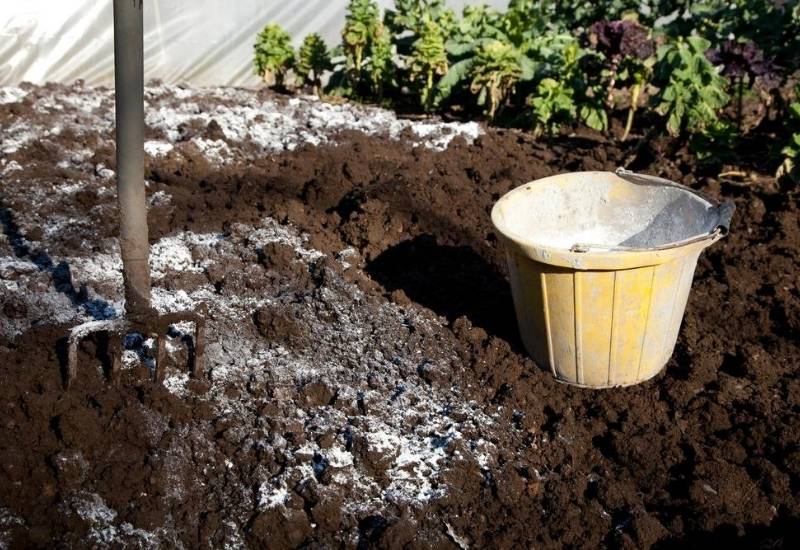
You could add lime to the soil to raise its pH, however… To start with, this would not be good for your conifers; and they would still strive, and manage, to change it back.
So you would end up with a continuous struggle with your trees, investing lots of time and effort to have little and transitory results.
Your soil will be much more fertile if you allow your pine trees to take care of its ecosystem. In short, it is far better to work with Nature than against it.
So, which are the best plants to grow in an acidic and shady environment like you find under pine trees?
15 Plants That Grow Well Under Pine Trees
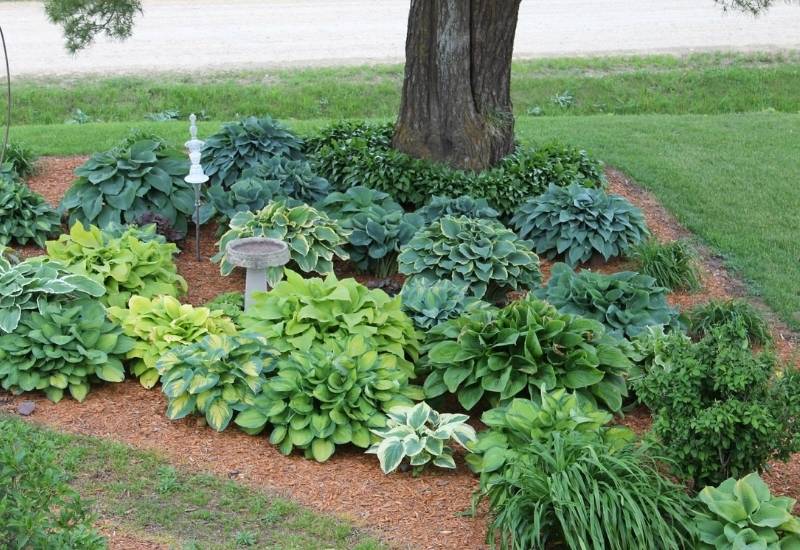
Divided up into perennials, shrubs and ground cover, here are 15 great plants you can grow under pine trees and conifers.
What Perennials Grow Under Pine Trees?
Very few annuals will grow under pine trees, because they need sunlight and most don’t take well to acidic soil, but perennial plants are different.
Many grow naturally in conifer forests, for example. So, let’s see what Nature has to offer.
1. Persian Violet (Cyclamen coum)
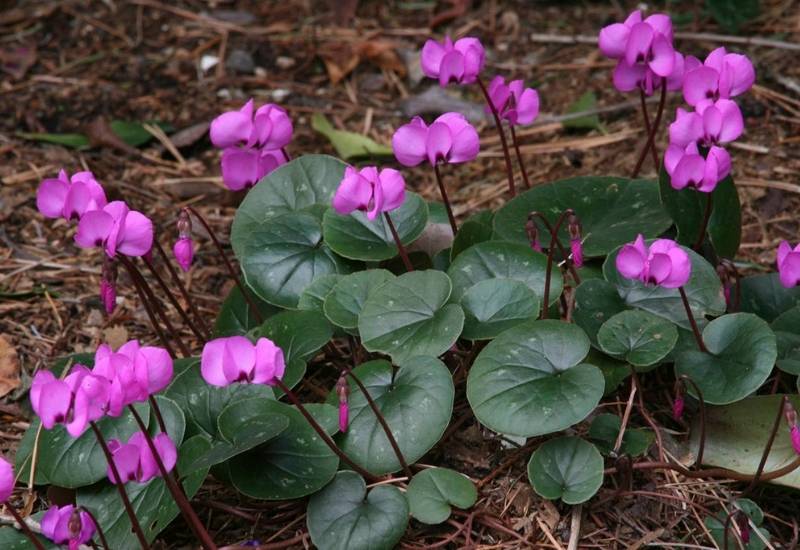
Persian violet is the most common cyclamen you find in pine forests in temperate regions of the world. They can literally fill the carpets of needles you find under conifers with seas of bright and unusual, reflex flowers, growing low in the shade of these evergreen trees.
With their distinct rosy purple petals, this small variety is a strong and reliable choice and an early boomer, perfect to announce spring in shady areas.
They will unfurl as buds on stems that come straight from the ground, and then open just as the days get longer.
The leaves are broad, dark green and heart shaped, with lighter spots on them, and they form small and sweet looking clumps. An alternative variety is hardy cyclamen, or Cyclamen neapolitanum.
This winner of the Award of Garden Merit by the Royal Horticultural Society naturalizes spontaneously in loose and fertile soil, as the corms multiply underground, and it can even offer a partial ground cover solution.
2. Daffodil (Narcissus spp.)
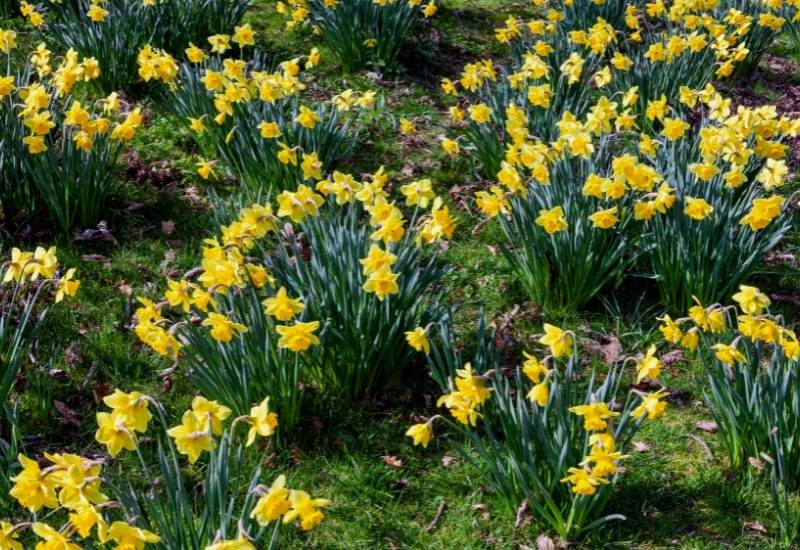
Daffodils grow well under many trees, including conifers and pine trees. They are massive bloomers with a very strong fragrance, and almost synonym with spring.
Of course, there are many varieties you can choose from, but more natural ones are best, like poet’s daffodil (Narcissus poeticus) and wild daffodil (Narcissus pseudonarcissus).
These are stronger and they adapt well to woodland habitats, just like under the thick canopies of needles. They also naturalize very promptly, and they require little maintenance.
Nevertheless, these are some of the best and most aromatic types of this mythical flower you can ever grow!
Planting daffodil bulbs under pine trees could not be easier, and you will be amazed to see their numbers grow year after year. Just split big clumps every two to three years, to help them propagate and spread them over a large area.
3. Grape Hyacinth (Muscari armeniacum)
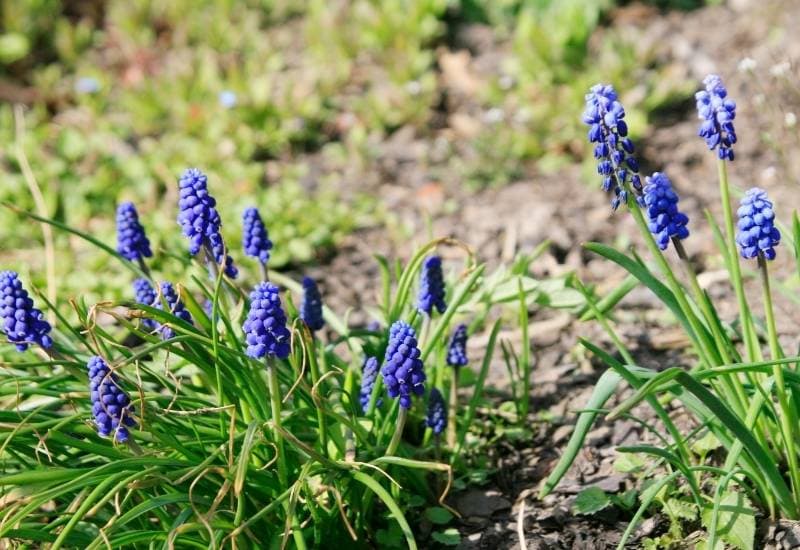
Grape hyacinth is yet another “natural” with forest and pine tree habitats.
Native of temperate woodlands, it can create wonderful effects with its sea of deep blue bell shaped flowers that blossom all at the same time, covering the underbrush with an explosion of color.
To be exact, there is a range of colors from dark blue to white, so you can diverge from the classic postcard look if you wish.
The spikes will crop up from the soil among lush and green foliage, made up of many long, fleshy and mid green leaves, like blades of grass.
The overall effect is very natural, and, for a while, they will actually work as ground cover. However, the leaves will soon disappear after the blooms are spent.
Grape hyacinth is yet another bulbous flowering perennial that you can easily naturalize; it is really not demanding, very forgiving and very generous indeed. In fact, one of the best choices if you want a massive effect for little money and effort under your pine trees.
4. Dwarf Crested Iris (Iris cristata)

Dwarf crested iris is a low growing perennial that grows well under conifers like pines or firs. It forms clumps of bright green sword shaped leaves that grow straight from the soil, where the rhizomes spread and naturalize easily.
The flowers come in groups of three, and they are blue violet in color, up to 4 inches across (or 15 cm).
They also have a white dash on the fall (the lower sepal) just around the bright yellow patch we call the beard. These plants like shady and humid places, and they are ideal for woodland areas.
Easy to grow, dwarf crested iris is a favorite with gardeners all over the world; while it is mainly appreciated in rock gardens, it will adapt to most other designs.
5. White Trillium (Trillium grandiflorum)
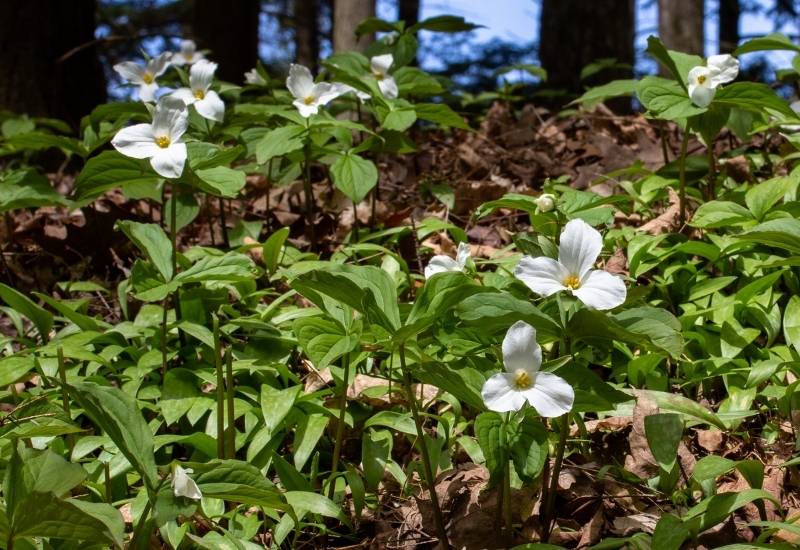
For showy blooms under pine trees and conifers, there is a great perennial for you: white trillium!
Its large flowers are the color of snow with bright yellow reproductive organs, and they have three, broad, showy and veined petals, and they can be 4 inches across (10 cm).
They will pop up from a dense clump of green foliage, each broad leaf is broad, pointed and quite decorative in itself.
You can let trillium spread, which will give you long lasting and generous blooms under the canopies of needles in spring and summer.
It is an ideal choice for large flowers in natural looking wild flower gardens and woodland habitats. It is also a winner of the Award of Garden Merit by the Royal Horticultural Society.
Easy to grow and fast spreading, white trillium is an excellent choice if you want a big show, with a candid display, but you have little money, time and resources to turn that carpet of needles into a sea of white and green.
6. Columbine (Aquilegia spp.)
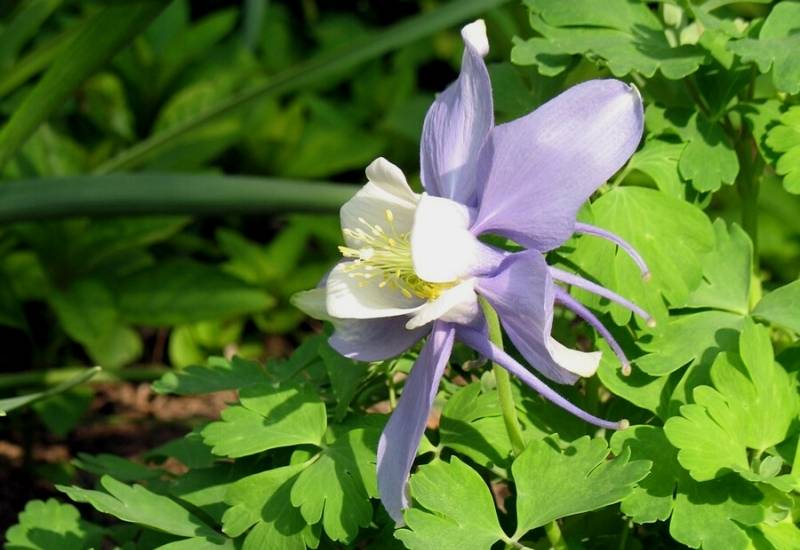
With columbines you have a wide range of colors and perennial varieties to grow under your pine trees.
In fact, these strong and adaptable flowering plants tolerate shady spots and prefer acidic soil, which is just what you need.
Their unusual looking nodding blooms come in a palette that goes from white to purple, including yellows, pinks, reds, oranges and some stunning hues of blue and violet!
Then again, you have multicolored blossoms as well, where the crown is usually different from the other petals.
Add the fern like foliage, which can be green or blue green, and you can see how you can transform your woodland garden into an amazing spectacle.
All columbines will do well under your pine trees, but if conditions are harsh and you want to be safe, choose a natural species rather than a cultivar, like Alpine columbine (Aquilegia alpina), Rocky Mountain columbine (Aquilegia cerulea) or Canadian columbine (Aquilegia canadiensis).
Shrubs That Thrive Under a Pine Tree
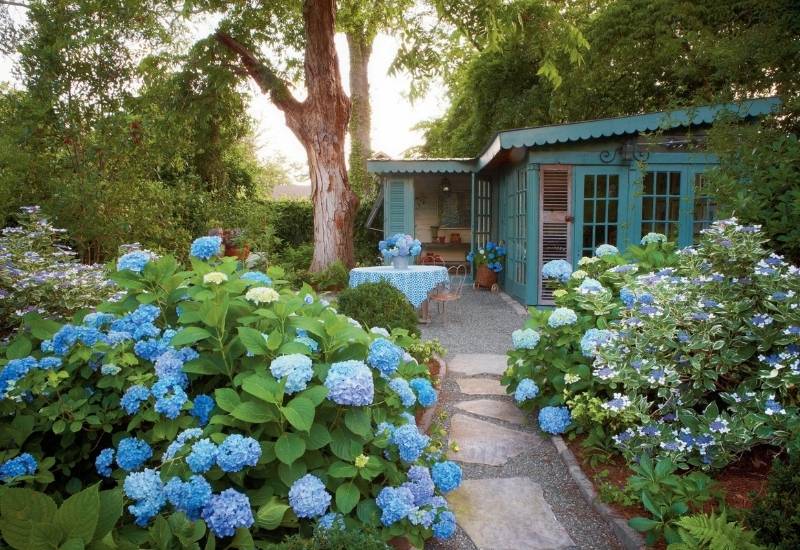
You can even grow some shrubs, large or small, under pine trees and conifers.
They will fill the space under their branches and thick canopies with lots of foliage and even flowers, giving structure and depth to your woodland garden.
7. Wintergreen (Gaultheria procumbens)
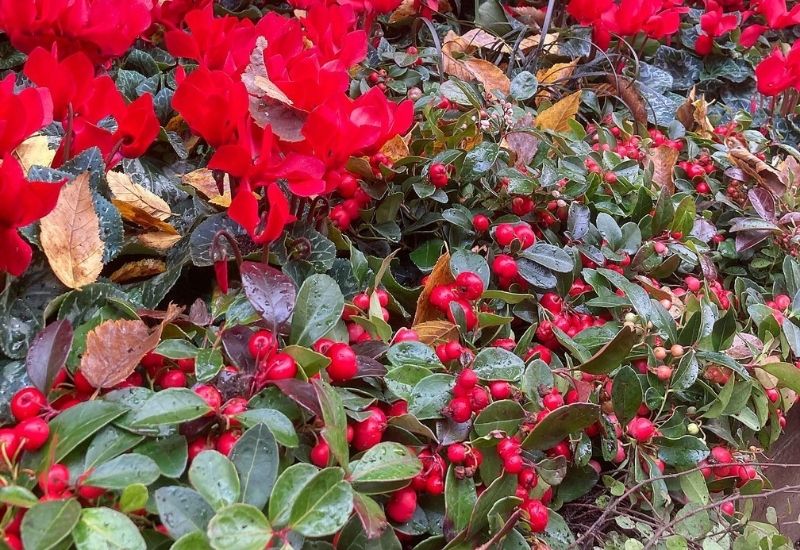
For a low shrub to grow under conifers and pine trees, wintergreen has a lot to offer.
Its broad, glossy and oval and leathery leaves form a thick cushion with a range of colors, from bright green to purple, and this changes as the season progresses, but they will stay in in winter too because it is evergreen.
Bell shaped, white flowers with a touch of pink will blossom in summer, and then, this little bush will follow its year round display with bright red and shiny berries that stay on all through the colder months and into spring!
They look like small apples, and they attract lots of birds to your green space.
Wintergreen is a shrub, true, but you can even use it for ground cover, if you plant many specimens under the canopies of your pine trees.
And you will have a gardening champion in your collection, because it has won the Award of Garden Merit by the Royal Horticultural Society.
8. Hydrangea (Hydrangea spp.)
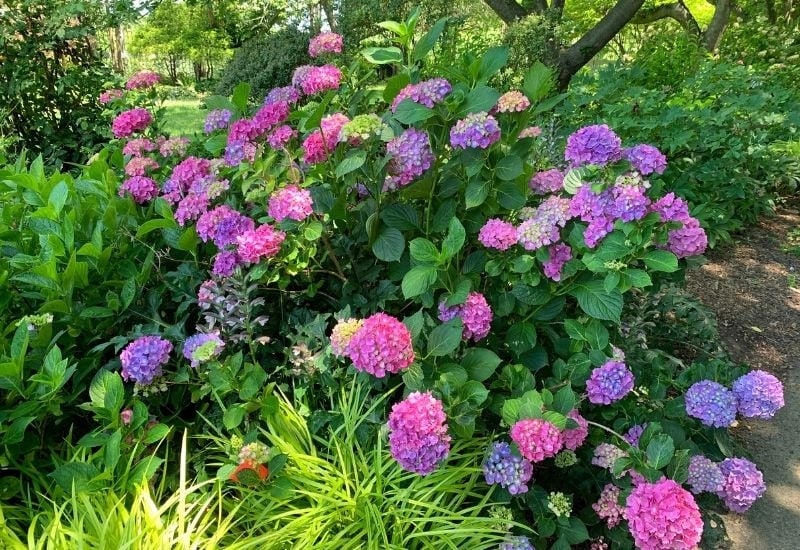
Hydrangea is an ideal flowering shrub for planting under conifers, as they like acidic soil, shade and the protection offered by pine trees. In fact, it likes the fact that it does not need to strain its roots to find nutrients when it grows under conifers. The range is huge, in size and color.
You can have blooms in any shade in the range from purple to white, including reds, oranges, pinks and even greens! Always coming in large and thick clusters and lasting for months, these flower displays can turn your shady area into an explosion of light.
There are so many varieties that it is hard to choose, but remember that there are also dwarf ones, in case you have a small garden.
There are some conditions to growing hydrangea under pine trees though. To start with, mulch them regularly to preserve soil humidity and nutrients.
Next, do not plant the just near the trunk; grow them at the edges of the shade area cast by the canopy, especially if the foliage is very thick.
9. Rhododendron and Azalea (Rhododendron spp.)
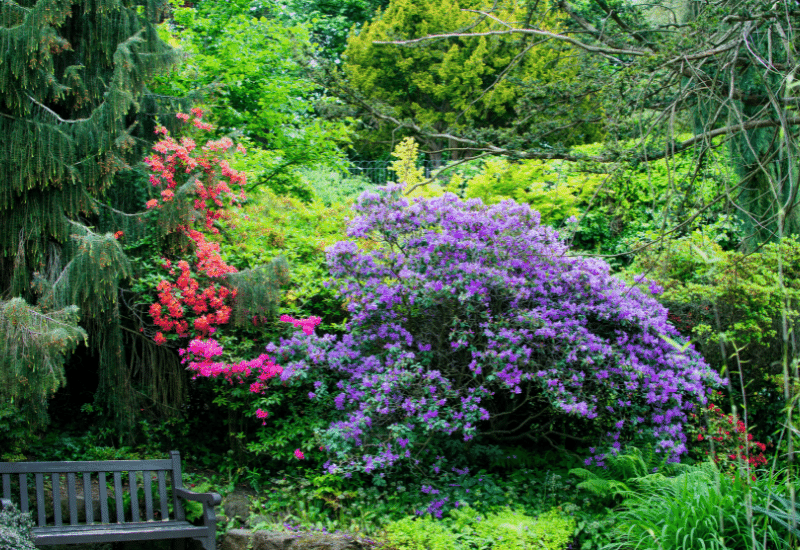
Rhododendrons and azaleas are by far some of the best flowering shrubs you can grow under pine trees. Acid loving, shade loving and immensely beautiful, these bushes fill with a sea of blooms that almost completely cover the whole plant.
One of the world’s favorite garden bushes, they come in all sizes and colors too. Their palette includes whites, yellows, pinks, oranges, reds and purples, but also blues and violets.
Some have larger blossoms, some smaller, some are fragrant too! Just take your pick, and there are also many award winners and a huge series of cultivars.
Rhododendrons and azaleas are iconic shrubs for woodland areas; there are two key secrets to make them happy: keep the soil loose, because they do not have strong roots, and make sure they have acidic soil, or just allow your pine trees to do that!
10. Gardenia (Gardenia spp.)
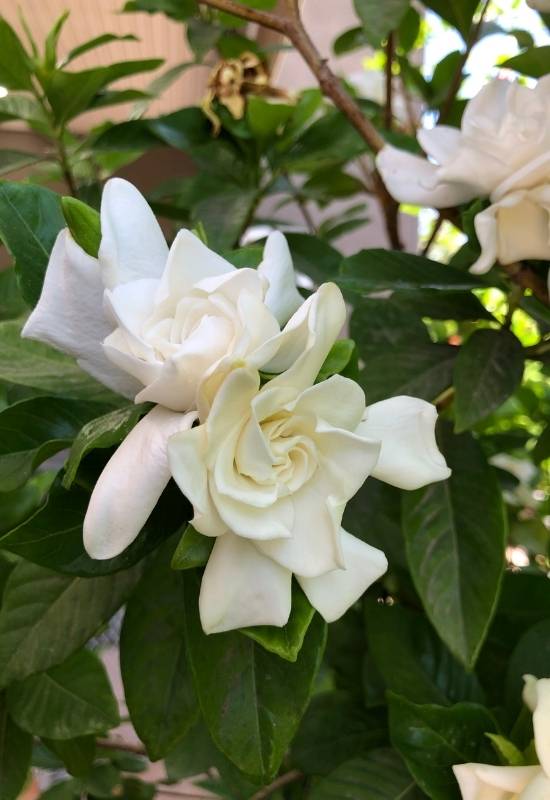
Gardenia, or cape jasmine, is a very picky shrub, but it loves the conditions you find under pine trees. In fact, it loves loose acidic soil, and it also likes to be sheltered from excessive sunlight. As you know, its white and rose like blooms are spectacular.
They can reach 6 inches across (15 cm) in some varieties, and they are always highly fragrant.
There are over 200 types you can choose from, all candid and beautiful. And let’s not forget the glossy, dark green, elliptical and thick foliage…
It often loses its sheen under deciduous trees, and the reason is the high soil pH. But conifers will make sure that this does not happen. The perfect companion for a pine woodland area.
The elegance of gardenias is hard to describe; they have that perfect look that suits both traditional western gardens like English country gardens, but also oriental designs, like Japanese gardens.
11. ‘Redwig’ American Cranberrybush (Viburnum trilobum ‘Redwig’)
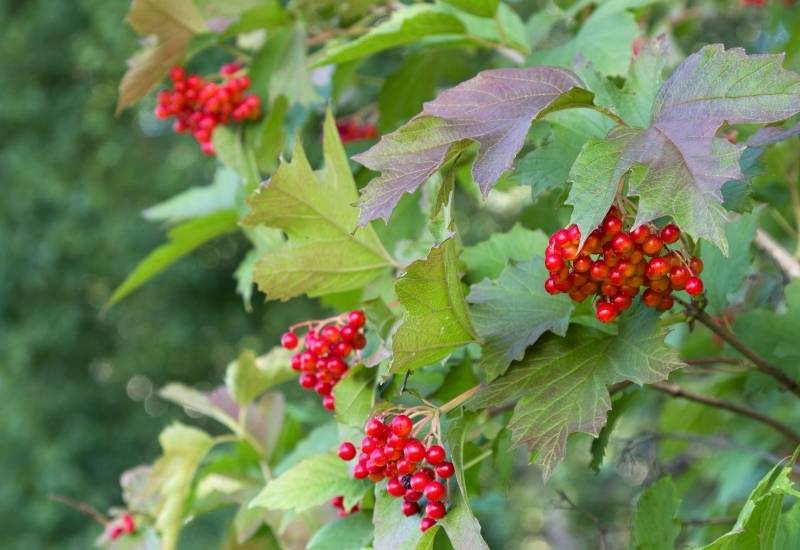
Bring a burst of flaming colors to your pine woodland with ‘Redwig’ American cranberrybush! Wait, it is a spectacle in spring too, when lace like cymes of flowers fill it with white blooms.
The mid green and lobed leaves already have some amaranth blushes at this stage, but you will also get lots of butterflies.
Then, in summer, you will see large drooping clusters of lava red berries, and birds will come to visit your garden and feast on them.
As days get shorter, the dense foliage on the thick branches will take on even deeper shades of red and orange, to close the season with a spectacle worthy of Canadian forests!
‘Redwig’ American cranberrybush is a cold hardy ever changing deciduous shrub that creates a great contrast with the green or blue canopy of needles of conifers and pine trees, and it is perfect for an emotionally charged landscape. And it is a winner of the Great Plants Award as well.
Groundcover Plants That Grow Well Under Pine Trees
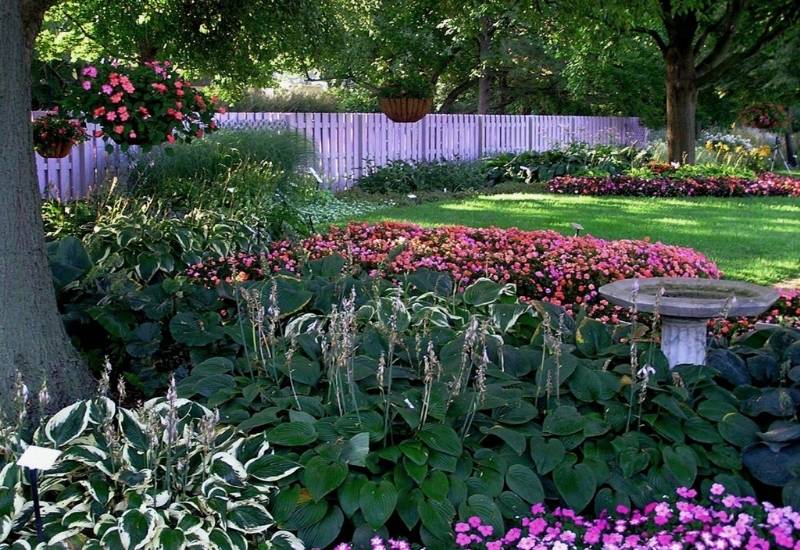
You don’t need to have a carpet of needles under your pine trees; there are some ground cover plants that will adapt perfectly well to this type of habitat. And here they are.
12. Meadow Anemone (Anemone canadensis)
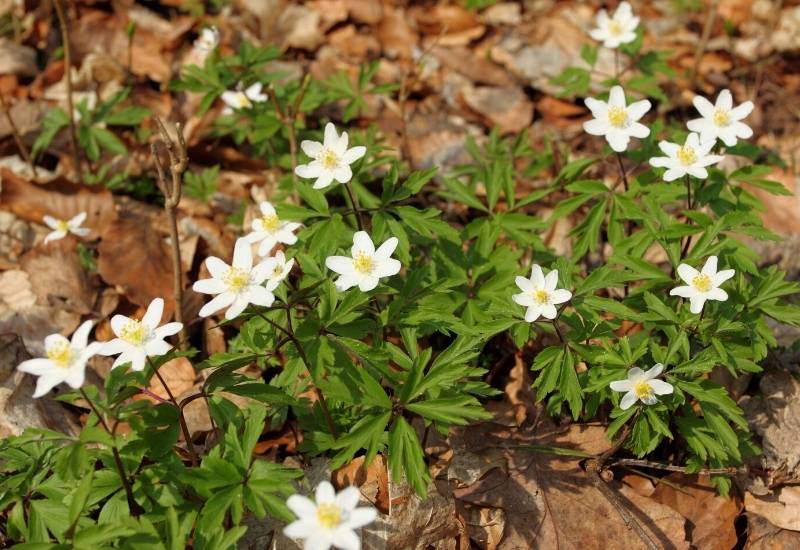
Meadow anemone is common in woodland areas where it forms dense carpets of richly textured mid green leaves. They will love the conditions you can offer under your pine trees and totally hide the layer of needles underneath its foliage.
It will also spread fast and it it has very low demands. On the other hand, it will offer you a sweet display of delicate looking erect flowers with white petals and a yellow center that look like scattered all over the emerald cushion, and they will last form months.
You will only need to plant a few meadow anemones under your pine trees to have a large result in a matter of months.
The underground rhizomes will spread far and wide, giving you a quick, cheap and easy solution and turning a brown floor of needles into a lush and fine carpet of green leaves and white flowers, even in cold areas.
13. Lady Fern (Athyrium filix-femina)
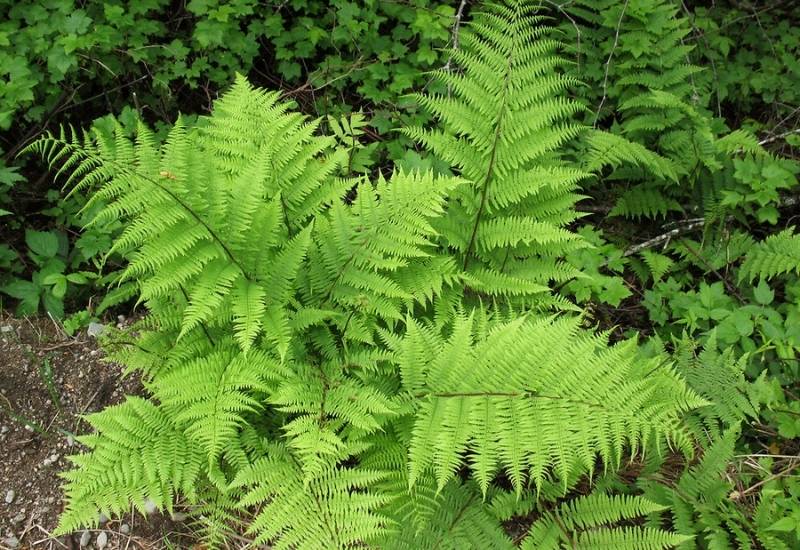
Lady fern is a natural ground cover plant in woodland areas, including pine forests. It likes shady spots under the thick canopies of trees, and it also likes acidic soil, which makes it perfect.
The fronds are beautiful, arching, triangular and finely segmented. Their light to mid green color just complements the elegant and fine texture.
This is a fern that looms impressive from a distance, where you can admire the rosette arrangement of the foliage, but also close by, where you can see the delicate details as well.
This winner of the Award of Garden Merit by the Royal Horticultural Society is easy to grow and it propagates naturally as well.
Lady fern is a temperate woodland classic; it is lush and strong, but it will need constant humidity to do well under your pine trees.
14. Hostas (Hosta spp.)
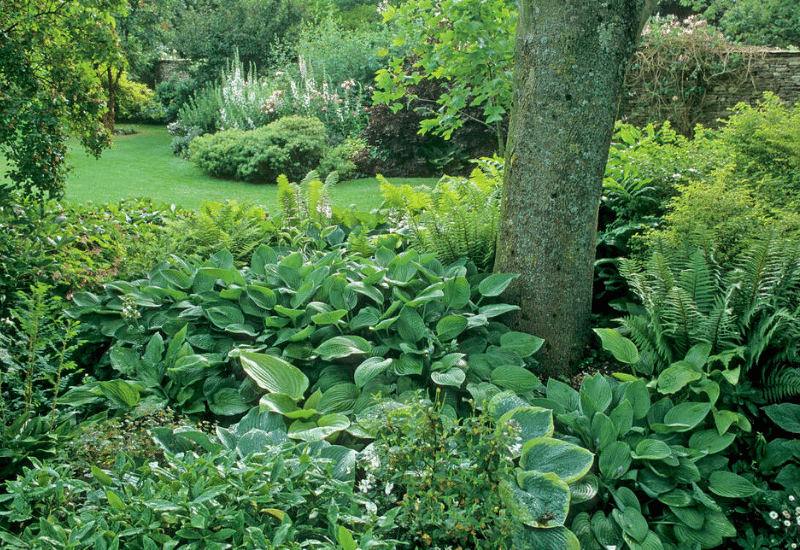
Grown mostly for their lovely foliage, Hostas (Plantain Lilies) are easy-to-grow, shade-loving perennials groundcover that love to grow under pine trees. Hostas in fact are excellent ground cover plants, but they need shade and prefer acidic soil.
Then again, they are favorites of snails and slugs, that love its fresh, fleshy, broad and tender pointed leaves.
While we love them because the form thick and lush clumps of heart shaped, green or variegated leaves, with blues, creams and yellows, our little animals love them for their taste.
Enter pine needles: these invertebrates cannot stand them, because, of course, imagine crawling on a bed of sharp and pointed “nails”…
You will have healthy plants and also their delicate white, pink or lavender blooms under your conifers.
Plantain lily will spread and form large clumps in the right conditions, and they will find them just where you thought you could grow no delicate plant: under the branches of your pine trees. Just make sure you water it regularly!
15. Lily of the Valley (Convallaria majalis)
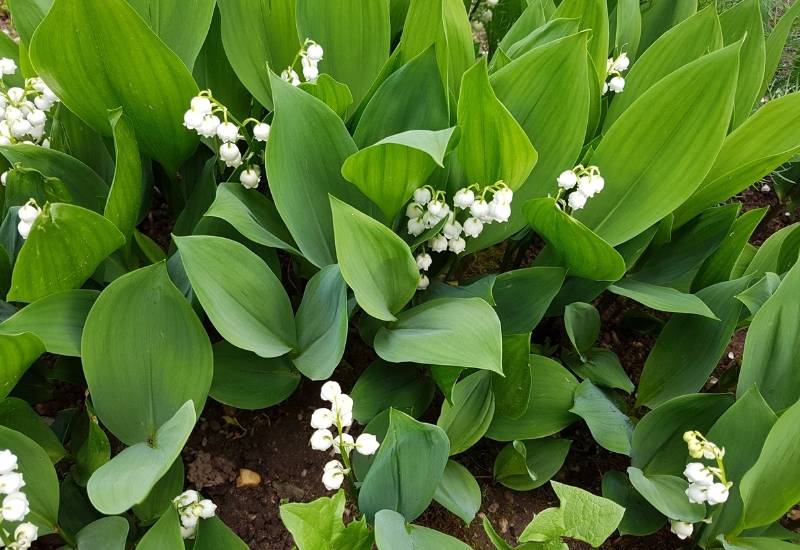
Lily of the valley covers ground under many trees, including in pine and conifer forests. And it does it in style!
Its broad, arching and pointed leaves grow straight from the soil, forming a thick layer of foliage and spreading naturally and fast.
In the mother species, they are bright to mid green, but in the cultivar ‘Albostriata’ they are dark with lime stripes.
Then again, you get the lovely bell shaped nodding flowers on the long stems to add to the effect. These are usually white, but Convallaria majalis var. rosea offers you a delicate lilac pink shade instead.
Very low maintenance and strong, it has also won the Award of Garden Merit by the Royal Horticultural Society.
Lily of the valley will give you the perfect woodland look as ground cover with little effort even in very cold climates; however, do remember that this plant is toxic if ingested, so, don’t be tempted to eat it.
No Plant Can Grow Under Pine Tees? Just A Myth!
Amateur gardeners always scratch their heads when they have to grow plants under pine trees.
But if it’s true that many will not thrive, ore even die, we know now that there are quite a few that will call the shady and acidic conditions home, and reward you for it!

Written By
Amber Noyes
Amber Noyes was born and raised in a suburban California town, San Mateo. She holds a master’s degree in horticulture from the University of California as well as a BS in Biology from the University of San Francisco. With experience working on an organic farm, water conservation research, farmers’ markets, and plant nursery, she understands what makes plants thrive and how we can better understand the connection between microclimate and plant health. When she’s not on the land, Amber loves informing people of new ideas/things related to gardening, especially organic gardening, houseplants, and growing plants in a small space.

I’m a ‘newbie’ to this aid to gardening. I’ve found the guidance here – about “What survives underneath pine trees?”
I shall now (well, when the season’s right), make a point of buying and planting what’s appropriate for the shaded area beneath an adult pine.
Thanks.
I was going to dive into the “area under the pine trees” and try to grow grass….until I read this article!!! Nope, I’m going to extend a garden from the pines with all the suggestions here! Which also means less grass to mow and a bonus for the bees and butterflies!!! I’m soooo happy I ran across this article!!!! Thank you!
The zone oindicate plant tolerance for cold weather. But what about the other end. How do these plants tolerate heat? We have weeks of temperatures in the mid nineties to mid one hundreds. Soe of our plants deal with the cold OK but need attention when it gets hot. Of these 15 plants, which tolerate heat the best (especially ground covers)?
Oh wow! I’m excited to plant some of these around my adult pine trees. I’m thinking a mixture of azalea, gardenia, and lady ferns! SO happy to know these plants will thrive there. English Garden here I come! Thanks!
Thank you this was very helpful, can someone comment are the cranberry’s discussed here the edible type please?
So glad I read this article. My husband and I put in about 75 daffodil bulbs last fall in the shade of some pines. Our other daffodils are up already, but nothing has shown under the trees. I thought perhaps they wouldn’t grow well there, but now think they are just a little slower as they are more shaded than our other daffodils in planting areas. Thus, I am looking forward to a nice batch of sunny daffodils under the pines as we get more into spring.
Did your daffodils ever pop up?
wow this article was so helpful! I am so excited to start planting I took on the replanting of three areas of the Elks golf course and thought I knew what I was doing. My husband trimmed on pine tree to where I can walk under, vast improvement. Now I can wait to plant under there
Thank you for this. Very succinct with a list. So many of these articles have the plants buried in the story.
Thank you so much for the tips!
Now the article has answered my question as to why the tall lilies I have planted just lived and bloomed for a year and never came back (though they were perennials).
A question though: Is there a variety of clematis that would thrive under a row of pine trees? I don’t refer to the Sweet Autumn Clematis variety but some other type(s).
Again, thanks.
Lilly of the valley is invasive on USA. It would be helpful if you steered people to restoring native plants and to avoid planting invasive plants. Affects entire ecosystems l.
Finally I’ve found you! I’m ready to create my narrow space under 4 Cypress pines. I’ve had coloured pots there for years so I’m very excited to explore the different perennials and Gardenias…wonderful and thank you.
How do you rake up the pine needles when the trees shed? If you have all these plants around the pine trees the needles will fall directly on the plant. That is my biggest worry about planting around the pine trees. Your expertise would be helpful.
Just rake up the dead needles, or better yet, leave them under the tree for a good mulch.
Thanks for the info. It was very helpful. I couldn’t seem to find perennial flowers that would grow under my Douglas firs.